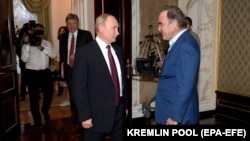On May 2, American film director Oliver Stone floated a conspiracy theory on Twitter, suggesting that the United States may be preparing a false-flag nuclear strike in Ukraine to blame Russia for killing thousands of Ukrainians.
Stone tweeted two screenshots with text and photographs, captioned: “My thoughts on some potential neocon objectives.”
Stone's tweet was shared more than 15,000 times by May 5:
“I wonder if the U.S. is setting a stage of a low-yield nuclear explosion, of unknown origin, somewhere in the Donbass region, killing thousands of Ukrainians. Of course… to blame Russia… regardless who launched the device.”
Stone’s conjecture is misleading and unsubstantiated.
He sidesteps a key U.S. point – that use of a nuclear weapon could lead to a dangerous escalation with devastating consequences, not just for the region but for the world.
And Stone overlooks the fact that it’s Russia, not the United States, that has made threats to go nuclear, ratcheting up tensions.
On February 27, just three days after Russia launched a full-scale invasion of Ukraine, Putin ordered his defense minister, Sergey Shoigu, and the chief of the general staff of the Russian armed forces, Valery Gerasimov, to raise Russia’s nuclear posture to “high alert.”
Putin has warned that any nation that tried to help Ukraine would face consequences “such as you have never seen in your entire history,” taken by many to mean nuclear retaliation.
The United States, rather than responding in kind, has taken clear steps to reduce tensions and nuclear weapons talk.
The U.S. could have raised its own nuclear defense posture, as France did after Putin’s warning. But it did not, with a senior defense official telling journalists at the Pentagon, “[W]e remained comfortable and confident in our own strategic deterrence posture.”
Moreover, on March 3, the U.S. canceled some routine nuclear missile tests that had been planned at least three years in advance, a decision made precisely to avoid sending an escalatory message to Moscow.
Pentagon spokesman John Kirby said that Defense Secretary Lloyd Austin made the decision “in an effort to demonstrate that we have no intention in engaging in any actions that can be misunderstood or misconstrued.”
In addition, no foreign false-flag operation, nuclear or otherwise, is needed to accuse Russia of killing Ukrainians. According to the United Nations High Commissioner’s office, in just three months, Russia’s war already has killed 6,546 people. The real number is likely far higher, the U.N. regularly reminds readers of its reports.
Russian troops in Ukraine have left behind mass graves of civilians and Ukraine defenders, dead bodies on the streets, victims of indiscriminate shelling and bombing, with many killed execution style and showing signs of torture and violent treatment.
Stone’s claim that the U.S. might attempt to portray Russia as “Satan” by detonating a nuclear attack is ironic, given that the West nicknamed Russia’s “Sarmat” nuclear missile system the “Satan.” On April 21, Russia test launched a new Sarmat missile, RS-28, that can carry 10 or more independently targeted nuclear warheads and uses a hypersonic delivery system.
In announcing the original model of the Sarmat back in 2018, Putin bragged about the rocket’s “unique” capabilities by using the U.S. state of Florida as a theoretical target.
Nuclear sable-rattling is not new in Russia. State-owned TV regularly uses graphics demonstrating how many seconds it would take for a Russian missile to hit each of Europe’s capitals.
Russian TV recently aired a simulation of how a nuclear strike on Ireland and the U.K. could wipe the countries off the map.
On a TV program this past week, the host and the guests discussed how easy it would be for Russia to turn London into radioactive ash – in a matter of seconds, they claimed.
Stone’s nuclear conspiracy post came a few days after Russian Foreign Minister Sergey Lavrov claimed that the West was spreading panic by engaging in nuclear war rhetoric. At the same time, though, Lavrov warned that the West should “not underestimate the threat of nuclear war.”
There are other peculiar coincidences in Stone’s Twitter feed. For instance, in a series of tweets on April 14, he denied that Russian troops committed an alleged massacre in Bucha, a suburb of the capital Kyiv, and accused Ukrainians of staging atrocities and killing their own relatives.
The Kremlin, Russia’s defense and foreign ministries and Putin himself made similar false claims.
A longtime supporter of Russia, Stone criticized Putin after the invasion, writing in a Facebook post in March: “Although the United States has many wars of aggression on its conscience, it doesn’t justify Mr. Putin’s aggression in Ukraine. Russia was wrong to invade.”
Still, he described Putin as a victim of a plot by the West:
“Putin has allowed himself to be baited and fallen into the trap set by the U.S. and has committed his military, empowering the worst conclusions the West can make,” the news outlet Deadline reported, quoting Stone's Facebook page.
Stone’s four-part documentary series “Putin’s Interviews” aired on the U.S. cable network Showtime in 2017. His complimentary portrayal of the Russian president prompted criticism. Some observers called Stone and Putin “natural born buddies;” others noted that Stone’s representation of Russia was false.
The Rolling Stone’s reviewer described the interview as “…a series of softballs lobbed lovingly in the direction of one of the most powerful and dangerous men in the world.”
Stone interviewed Putin again in 2019. According to the transcript published by the Kremlin, Stone asked Putin to become a godfather for his daughter.






